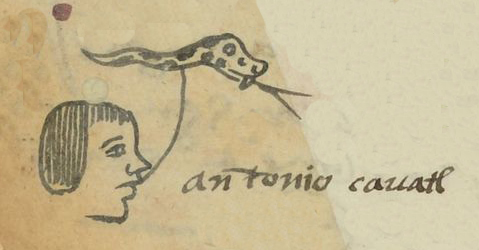Coatl (MH484v)
This simples glyph stands for the personal name Coatl (serpent or snake). In this black line drawing, the snake is shown stretched out horizontally and in profile, looking to the viewer's right. Its forked tongue protrudes. One eye is visible. It also has spots. No rattles are visible.
Stephanie Wood
This day sign, coatl, comes from the tonalpohualli, the 260-day religious divinatory calendar. Calendrics figure importantly in Nahuas' religious views of the cosmos. Men, especially, seem to have carried this name. A wooden, turquoise-mosaic pectoral in the shape of a snake is held in the British Museum, whose curators have written: "The Mexica considered serpents to be powerful, multifaceted creatures that could bridge the spheres (the underworld, water and sky) owing to their physical and mythical characteristics."
Stephanie Wood
antonio couatl
Antonio Coatl
Stephanie Wood
1560
Xitlali Torres
snakes, serpents, serpientes, víboras, cohuatl, crótalos

coa(tl), snake, serpent, https://nahuatl.wired-humanities.org/content/coatl
El Serpiente
Stephanie Wood
Matrícula de Huexotzinco, folio 484v, World Digital Library, https://www.loc.gov/resource/gdcwdl.wdl_15282/?sp=48&st=image.
This manuscript is hosted by the Library of Congress and the World Digital Library; used here with the Creative Commons, “Attribution-NonCommercial-ShareAlike 3.0 License” (CC-BY-NC-SAq 3.0).


